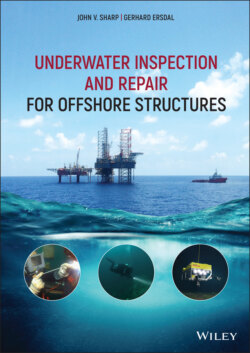Читать книгу Underwater Inspection and Repair for Offshore Structures - Gerhard Ersdal - Страница 32
2.3.4 ISO 19902
ОглавлениеThe development of the international standard ISO 19902 (ISO 2007), concerned with fixed offshore structures began in 1993, including a section on structural integrity management in the early drafts. This standard was first issued formally in 2007, but the early drafts were used as the basis for structural integrity management in the period from 1993 to 2007. In 2019 the SIM part of this standard was transferred to a new ISO standard, ISO 19901‐9 (ISO 2019a), which focused on structural integrity management and assessment of existing structures.
The ISO 19902 (ISO 2007) took into account all the issues and methods that had been used to inspect, monitor, evaluate and assess fixed offshore steel structures over the previous years. ISO 19902 (ISO 2007) described four different types of inspection of the structure as shown below:
baseline: inspection soon after installation and commissioning to detect any defects arising from fabrication or damage during installation;
periodic: inspection to detect deterioration or damage over time and discover any unknown defects;
special: inspection required after repairs or to monitor known defects, damage or scour;
unscheduled: inspection undertaken after a major environmental event such as a severe storm, hurricane, earthquake or after an accidental event such as a vessel impact or dropped objects.
ISO 19902 (ISO 2007) stated that “the purpose of in‐service structural inspection is to determine, with a reasonable level of confidence, the existence and extent of deterioration, defects, or damage. Data collected during an inspection are needed to verify the integrity of the structure”.
ISO 19902 (ISO 2007) described the process of managing the integrity of structures with four major elements as shown in Figure 9, where inspection is the key element of both the long‐term surveillance plan and particularly the surveillance execution. The remaining two processes include the storage of inspection data and the evaluation of possible anomalies found during inspection.
Figure 9 Structural integrity management cycle (surveillance includes inspection of the condition, determination of loading, review of documents, etc., needed to determine changes that may affect the safety of the structure).
Source: Based on ISO (2007), ISO 19902:2007 Petroleum and natural gas industries—Fixed steel offshore structures, International Standardization Organization.
Assessment was introduced in ISO 19902 (ISO 2007) as an option following engineering evaluation if anomalies identified during inspection require a more detailed analysis.
A possible outcome of the evaluation or the assessment is the implementation of prevention measures which include structural strengthening and reduction of loads on the structure or mitigation actions; these might include measures such as operational restrictions and possible de‐manning.
